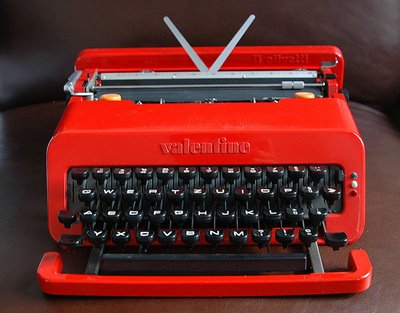
found it interesting that mcmurtrie uses the word “cult” to describe the typographic trend of expanding the usage of lowercase letters. okay, i found it interesting, and maybe an intcie bit offensive seeing as i am one to have jumped on –rather, have been blindsided by- the bandwagon of this style. i am coming to the realization that I have no legitimate defense in using the technique after reading of its origin and i also believe the trend was indefensible in its first uses. however, i am more intrigued by the evolution of lowercase usage, which seems to point toward a more sound defense. (let’s hope.)
i agree that the lowercase is the easier read, maybe that is why i feel more comfortable using them. lowercase letterforms have a certain comfortable persona, they leave a gentle feel to a typographic body.
SIMILAR TO LOWERCASE, CAPITALS ALSO HAVE A PERSONA. in recent years, with the advent of on-line instant messaging the use of the capital letter allows one to show emotion or attitude through a computer screen. our conversation is so incredibly complex that, without that physical presence the intonation, accent, and obvious punctuating characteristics of someone’s voice (not to mention body language), other means may be necessary to represent these things. for example, the phrases, “ I HATE YOU,” and, “ i hate you,” sound a lot different in your head.
i don’t think that tradition is the single cause for uppercase use. our culture has developed rules and standards set to capital letters, therefore the easy read may be what more people understand. for instance, “god” and “God.” this is a HUGE ( <--you like that?) issue, proving my point that the capital “G” is used to differentiate one god from another. “god” often refers to any god other than the one Jewish God.? capital letters, in our language serve many purposes. many people agree that English is by far the most complicated language, maybe one reason this is true is because we have purposeful laws based upon the use of distinct letterforms. capital letters represent proper nouns, proper nouns in speech are easily identifiable, therefore easy to read. example; the word “mom” in text may not distinctly refer to your “Mom” or my “Mom” as our speech enables us to project more clearly.
i won’t let mcmurtrie take the heat for bringing up the notion for the tradition argument though, it’s just- I feel the need to defend the capital because , yes, i would surely be disconcerted if it wasn’t there anymore. and maybe this means that i really am subject to the tradition. you’ll notice, in trying to use only lowercase letters for the majority of this writing, i cannot break the habit of capitalizing out of obligation or respect to the entity the word refers to. tradition or not, they are not going away because it is what people know and understand best. capitals are not convenience, they’re defensible standards of our language. the use of lowercase might negate such standards, but that might be why it is identified by stylistic techniques, not tradition. for myself, the cockroach typographic style has been, if nothing other than a style, a learning tool. it begs questions like, “why is it more comfortable?” or, “ why does it look more unified?” questions mean answers, mean learning.
p.s. how did you read these sentence?:
“… it begs questions like, “why is it more comfortable?” or, “ why does it look more unified?” questions mean answers, mean learning. “
yes, i meant for this to be two sentences, read like this; “ It begs questions like, “Why is it more comfortable?” or, “ Why does it look more unified?” Questions mean answers, mean learning. “
without capitals, the punctuation at the end of the first sentence (if i even typed it right) does not give the idea of the sentence break, therefore the sentences run into one another. there is a time for lowercase, and being able to define that moment has now become a responsibility.




